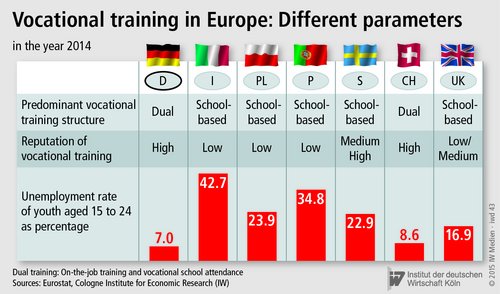In view of the high rate of youth unemployment in parts of Europe, all countries should attempt to make their vocational training programmes more appealing.
Vocational training: Five success factors
Some European countries have a youth unemployment rate exceeding 40 per cent. In other countries, such as Germany and Switzerland, the rate is relatively low (see chart). The fact that young people here experience a smoother transition into their working life than those in other countries can largely be attributed to dual vocational training programmes.
Because of the particular circumstances in countries with a high rate of youth unemployment, a simple “export” of Germany’s dual vocational training system to these countries is not a realistic solution. After all, in established educational systems, reforms only succeed to the extent that they can be coherently implemented into the existing structures. Furthermore, other European countries are pursuing innovative paths in vocational training which Germany, in turn, can learn from. The following factors are crucial to the success of training initiatives:
Acceptance. The success of vocational training hinges on its acceptance by a country’s people and businesses.
In countries where vocational training is of high quality and, hence, is highly regarded, youth unemployment is comparatively low.
In Italy, Portugal and the UK, however, vocational training is seen as a second choice or back-up plan for many young people – in case things do not work out with their studies.
Involvement of businesses. The more businesses get involved in vocational training, the better the possibilities for the young generation on the employment market. After all, this is how trainees learn what exactly is required in everyday working life.
But this involvement cannot simply be exported overnight. Countries with well-established dual vocational systems have a long tradition of such involvement. However, in the many countries whose educational system is predominantly school-based, such as Sweden or Portugal, people must first be convinced of the benefits of a dual system. In the UK, for example, the government has offered financial incentives to encourage companies to get involved in the dual training system – and with increasing success.
Social partnerships. Active social partnerships are helpful to ensure the training is provided in the most practice-oriented way. In Germany, employers’ associations and labour unions have been jointly developing training regulations for decades. However, branch-specific programme advisory committees – such as those already formed in Sweden, Portugal and the UK – could serve as a first step in this direction.
Mobility. Youth and their parents find a vocational training programme particularly appealing if it leaves the door open for further education. In Poland, for instance, young people automatically receive a university entrance qualification when they complete their vocational training.
Relevance to the employment market. Vocational training is especially successful if it keeps up with the constant changes of the working world.
In Germany, training regulations are formulated in a manner that is technology-neutral and open-structured. This enables companies to familiarise trainees with the latest technologies and processes. In the UK, and increasingly in Poland, qualifications have a modular structure and can be individually updated and combined as necessary during the course of the training programme.
More on the topic

What factors influence the career ambitions of people with disabilities?
Many companies in Germany report having difficulties not only in recruiting employees, but also in filling vacant management positions.
IW
Artificial Intelligence – Will Boosted Productivity Lead to Better Pay?
Artificial intelligence (AI) is already being used in a wide variety of applications both inside and outside the corporate world.
IW
